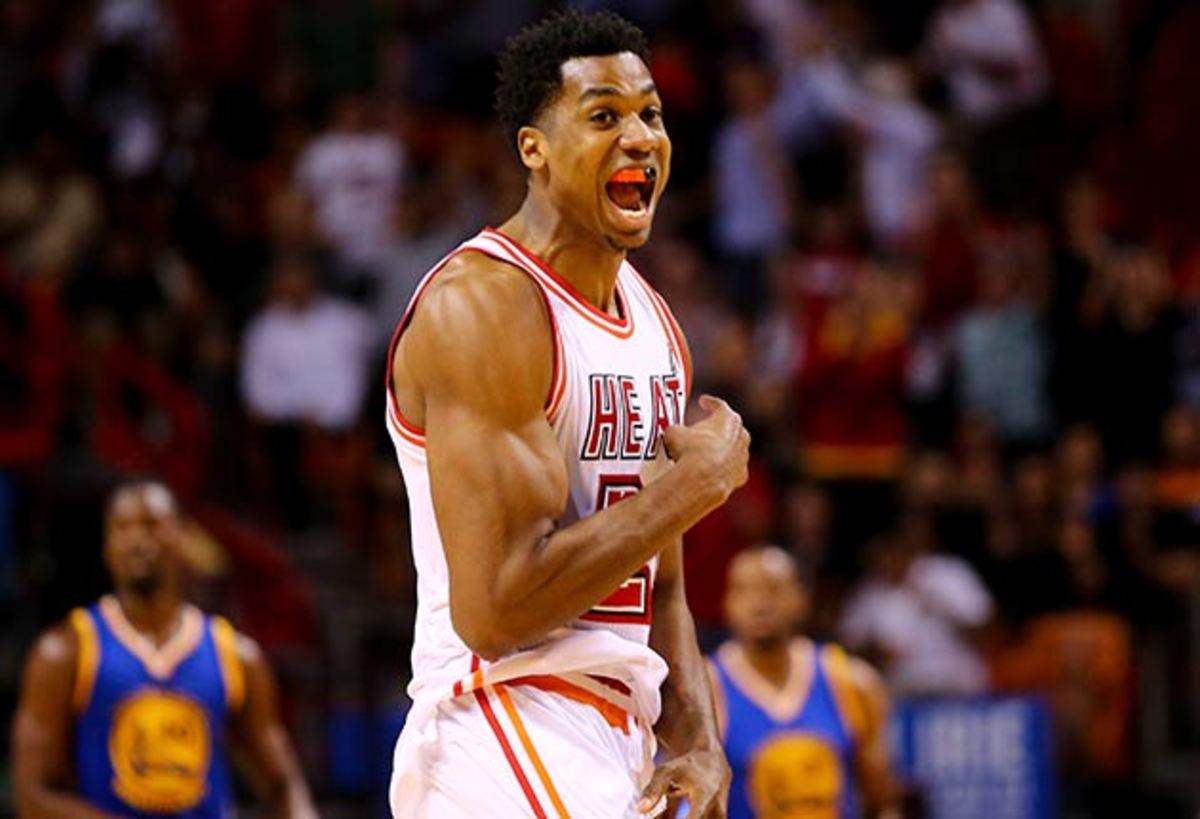Who wants to pay Hassan Whiteside? Examining his best fit in free agency

Your teams. Your favorite writers. Wherever you want them. Personalize SI with our new App. Install on iOS or Android.
Outside of Kevin Durant, Heat center Hassan Whiteside may be the most intriguing free agent on the market this summer.
Out of the top 15 players on Rob Mahoney’s Top 50 Free Agents list, Whiteside is easily the biggest unknown. While many of the other big names on the market have played in the league long enough for teams to know what to expect from them, Whiteside barely boasts one-and-a-half seasons of consistent playing time in the Association. Even still, the 27-year-old is expected to command a max contract on the open market.
Is the mercurial center worth the money? And who’s lining up to pay Whiteside? Let’s take a closer look.
So, is Whiteside any good?
Whiteside’s stats are certainly eye-popping. He averaged 14.2 points, 11.8 rebounds and a league-leading 3.7 blocks per game last season. Whiteside’s Per 36 Minute numbers are even more head turning: 17.6 points, 14.7 boards and 4.6 rejections. At his best, Whiteside roams the paint, blocking shots when his team’s perimeter D breaks down, and forces shooters to second-guess when entering the paint. Just re-watch the Charlotte Hornets in their Game 7 loss to the Heat in the first round of the 2016 playoffs—as Whiteside heated up, Hornets players would penetrate the lane only to meekly dribble out when encountering Whiteside. When he’s fully engaged, Whiteside’s presence is enough to deter teams from even attacking the rim.
But there are questions as to whether Whiteside’s stats are somewhat empty. The Heat grabbed a higher percentage of defensive boards with Whiteside off the court, and Miami’s defensive rating dropped by less than a point with Whiteside on the bench. Whiteside’s blocks look great on paper, but he often chases shots that leave his team susceptible to offensive rebounds and second-chance points. (Whiteside did account for a huge difference in Miami’s offensive rebounding, however.)

Offensively, Whiteside earns his money on lobs, as he can be a destructive force after setting a screen. His post game looks ugly, but Whiteside also manages to score off some zany line-drive hook shots. His free throws have gotten better, making him a less and less likely target to be hacked. His passing—or utter lack thereof—leaves a lot to be desired. But did I mention the lobs? Although teams were able to slow down Whiteside’s roll action during the postseason, doing so opened up spaces for ball handlers and shooters. Essentially, Whiteside must always be a top priority when he’s running toward the basket, which can put a lot of strain on defenses.
There are, however, smaller facets of Whiteside’s game that need fine tuning. His screen setting was maddening to watch for large stretches of last season, to the obvious dismay of Heat guards. Whiteside’s pick-and-roll defense also remains a work in progress, as he often remains a step or two closer to the paint against ball-handlers who can shoot from distance. His defensive deficiencies extend to the post, where big men with a couple of moves—see: Jonas Valanciunas and Al Jefferson—can wreak havoc. And Whiteside’s attitude is best described as enigmatic, as he can disappear for quarters at a time before erupting.
• Open Floor Podcast: NBA draft winners/losers, strange moves, more
To his credit, Whiteside improved both his pick-and-roll coverage and screens in the second half this season, particularly after the All-Star break. Whiteside himself admitted his chemistry with point guard GoranDragic grew toward the end of the season, and he showed a greater willingness to defend on the perimeter, especially after his responsibilities grew in the absence of Chris Bosh.
The only issue? Whiteside is already 27, so though he may be green in some aspects, it’s difficult to project if he will progress like someone else who has only played less than two full seasons in his career. Whiteside’s post-All-Star break improvement was encouraging last season, but he’s likely to plateau sooner rather than later. Whoever signs him will be putting a lot of faith in their coaches to hammer home some defensive concepts.
So who’s trying to sign him?
Right now, there are four teams who’ve been reportedly expressed the most interest in Whiteside: the Lakers, Heat, Blazers and Mavericks. Let’s take a look at how Whiteside could fit in with each.
Portland Trail Blazers
Portland is looking for an impact big after losing LaMarcus Aldridge in free agency last year. The Blazers struck out on Enes Kanter in restricted free agency in 2015, but will have another chance to bring home a center this July. Whiteside would certainly help the backline of Portland’s defense, and could clean up mistakes C.J. McCollum, Damian Lillard and Gerald Henderson make on the perimeter. Whiteside could also form an exciting pick-and-roll combo with McCollum and Lillard, but their bombs away attitude may frustrate a center expecting touches. And when teams—as they often do against PDX—blitz Lillard and McCollum off picks, can Whiteside act as the release valve in 4-on-3 situations? In a limited number of plays, Whiteside struggled when catching the ball at the foul line in Miami. He often missed open shooters in the corner, and threw up a lot of awkward floaters one step inside the lane. But any time Portland’s guards make a hard charge to the rim, Whiteside would be well-positioned to eat.
• Kevin Durant and who? Top 50 players in the 2016 NBA free agency
Dallas Mavericks
After their well-documented dalliance with DeAndre Jordan last summer, the Mavs were left with Zaza Pachulia as their center for much of last season. Though Pachulia assimilated well, Whiteside would be a major upgrade at the five spot. In an ideal world, Whiteside would operate in Dallas the way Tyson Chandler did during the team’s championship year—providing stout defense at the rim and playing exclusively off pick-and-rolls on offense. In that sense, Dallas seems like a nice fit for Whiteside. He can be the defensive anchor the team needs alongside Dirk Nowitzki. And offensively, Whiteside could be a force under Rick Carlisle’s quirky genius. What the Mavs may lack is the proper guard to pair with Whiteside. Dallas’s elder statesmen in the backcourt aren’t exactly the type to instill fear coming off picks, and while J.J. Barea has a fun chemistry with Dirk, he could find Whiteside’s inconsistent screens as a nuisance. Also, if the Mavs are hell-bent on turning Whiteside into a superstar in the way they pitched Jordan, they’ll have to live with a number of failed post-ups. But Dallas would likely be a fun fit. Carlisle’s guru magic + Dirk’s offensive gravity + a commitment to Chandler-esque defense would make Hassan an impact player.
Los Angeles Lakers
The situation here is a little unclear, to be honest. What kind of offense will Luke Walton run? If he wants to be like the Warriors, Whiteside doesn’t really have the passing ability to emulate Andrew Bogut. Will Walton want to play a more traditional, throwback-Lakers-style offense? Well, Whiteside isn’t exactly someone you throw the ball to on the block. The Lakers will also have to decide how Whiteside will pair with D’Angelo Russell, their young point guard who is still a bit of a mystery after a lost season. The Lakers have a young nucleus forming with Russell, No. 2 overall pick Brandon Ingram, Julius Randle and Jordan Clarkson. Does Whiteside really fit the same timeline as that group? And could his attitude create an uncomfortable locker room? It’s also hard to imagine Whiteside lining up in a frontcourt with Randle, as the lack of shooting could spell death in the modern NBA. The Lakers love centers and big splashes, and Whiteside would be both. He would become another chess piece for Walton to move around, and adding talent is never a bad thing, but it’s nearly impossible to determine how Whiteside would look in L.A.
• USA Basketball's roster for Rio falls well short of Dream Team status
Miami Heat
The Heat’s pursuit of Whiteside is made murky by the Chris Bosh situation. If Bosh is healthy, Whiteside doesn’t make sense on a max deal. Bosh and Whiteside struggled when sharing the court last season, and Erik Spoelstra often went with only one big down the stretch of close games. The Heat’s offense only took off once Bosh was hurt, which forced the team to play small. If Bosh returns, the Heat could end up paying Whiteside to come off the bench, or force themselves to make an awkward frontcourt work with a backcourt that wants to run. Of course, if Bosh’s health situation is still up in the air, the Heat surely remember Whiteside was an integral part of the team’s second-half offensive surge. If Whiteside never sprained his knee in the playoffs, he potentially could have helped Miami reach the East Finals—no small feat without Bosh. Retaining Whiteside would give Miami a group of youngsters—a group including Justise Winslow, Tyler Johnson and Josh Richardson—that could be a part of the team in a post-Wade world. The Heat also know Whiteside best, which could give them the upper hand in dealing with his mood swings. It’s not a perfect fit, but it’s a fit that could be borne out of necessity.
